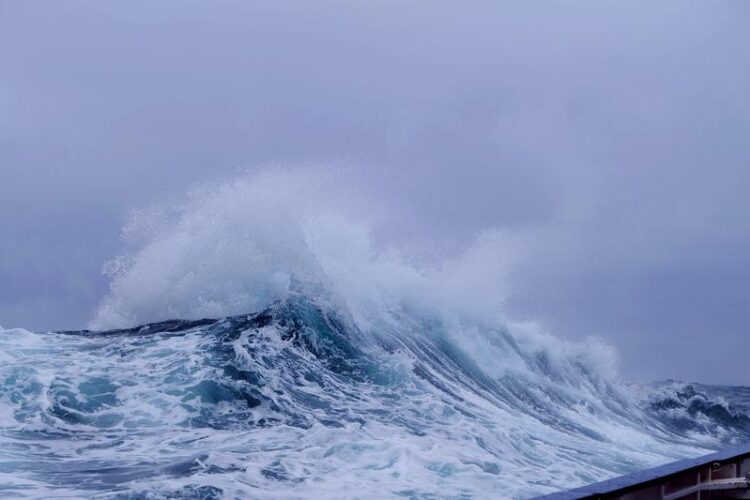Oceans release microplastics into the atmosphere

During stormy weather, sea spray can carry microplastics into the air. The photo was taken during a trip of the research vessel Heincke off the Norwegian coast in June 2021.
Photo: Alvise Vianello
Tiny plastic particles can be found in the air over the oceans even far away from the coast. According to a new study, microplastics are not only carried by the wind, but also escape into the atmosphere from seawater. For the first time, German and Norwegian researchers led by the University of Oldenburg present data on the composition and sources of different types of plastic in the air over the North Atlantic and the origin of the particles. The results were recently published in the journal Nature Communications.
Microplastic particles are present in the marine atmosphere even in remote parts of the world. These tiny particles come from land sources but are also re-emitted into the atmosphere from the sea, a study by a team of German and Norwegian researchers led by Dr Barbara Scholz-Böttcher of the University of Oldenburg has shown. The scientists analysed air samples taken from various sites along the Norwegian coast all the way up to the Arctic region. The results have now been published in the scientific journal Nature Communications.
“With our study, we present data on the mass load of different types of plastic in the marine atmosphere for the first time,” said Isabel Goßmann, a doctoral candidate at the University of Oldenburg’s Institute for Chemistry and Biology of the Marine Environment (ICBM) and first author of the paper. The research team collected the samples during an expedition with the Research Vessel Heincke in 2021. The northernmost destination was Bear Island, the most southerly island of the Svalbard archipelago which lies halfway between the mainland and the archipelago’s largest island, Spitsbergen. The team used two different devices to collect air samples. The devices actively pumped in air and were mounted on the bow of the research vessel at a height of twelve metres.
The scientists analysed the air samples using pyrolysis-gas chromatography-mass spectrometry. With this method they were able to identify and quantify the different types of plastics in the atmosphere through thermal degradation and selective analysis. They then performed model calculations and reconstructed the sources and distribution paths of the particles, each of which is just a few thousandths of a millimetre in size.
The analysis revealed the omnipresence of polyester particles. Polyethylene terephthalate particles, which presumably entered the atmosphere in the form of textile fibres, were detected in all samples.
Other plastic types were also present, including polypropylene polycarbonate and polystyrene. Tire wear particles, the tiny debris abraded from tires during driving and especially braking, were identified as another major source of microplastics. The researchers measured concentrations of up to 37.5 nanograms (one nanogram = one-billionth of a gram) of microplastics per cubic metre of air. “These pollutants are ubiquitous. We find them even in remote polar regions,” Goßmann stressed.
Until now, little was known about microplastics pollution levels including tire wear particles in the marine atmosphere. “There are only a handful of studies on the concentration of these pollutants in the air,” said team leader Scholz-Böttcher. “Our model calculations indicate that the microplastics in the marine atmosphere come from direct sources on the land as well as from the sea,” she added. The team posits that plastic particles floating near the sea surface enter the atmosphere via sea spray and bursting air bubbles produced during stormy weather, for example.
Microplastics find their way into seawater via rivers, but also through the atmosphere – particles are washed out of the atmosphere by rain, for example. Another potential source is ship traffic: in an earlier study, a team led by Scholz-Böttcher demonstrated that in the open North Sea, the paint and coatings used on ships is the main source of microplastics. In the current study, chemicals such as polyurethanes and epoxy resins typically used in paints and coatings for ships were also found in the air samples.
In addition to researchers from the ICBM, scientists from the Alfred Wegener Institute, Helmholtz Centre for Polar and Marine Research (AWI) in Bremerhaven, the Technische Universität Berlin, the Norwegian Institute for Air Research (NILU) and the Norwegian Institute of Public Health (NIPH) were also part of the research team.
Wissenschaftliche Ansprechpartner:
Dr. Barbara Scholz-Böttcher, Phone: 0441/798-5362, Email: barbara.scholz.boettcher@uol.de
Originalpublikation:
Isabel Goßmann et al: “Occurrence and backtracking of microplastic mass loads including tire wear particles in northern Atlantic air”, Nature Communications 14, 3707 (2023). https://doi.org/10.1038/s41467-023-39340-5
Weitere Informationen:
Media Contact
All latest news from the category: Ecology, The Environment and Conservation
This complex theme deals primarily with interactions between organisms and the environmental factors that impact them, but to a greater extent between individual inanimate environmental factors.
innovations-report offers informative reports and articles on topics such as climate protection, landscape conservation, ecological systems, wildlife and nature parks and ecosystem efficiency and balance.
Newest articles

Innovative 3D printed scaffolds offer new hope for bone healing
Researchers at the Institute for Bioengineering of Catalonia have developed novel 3D printed PLA-CaP scaffolds that promote blood vessel formation, ensuring better healing and regeneration of bone tissue. Bone is…

The surprising role of gut infection in Alzheimer’s disease
ASU- and Banner Alzheimer’s Institute-led study implicates link between a common virus and the disease, which travels from the gut to the brain and may be a target for antiviral…

Molecular gardening: New enzymes discovered for protein modification pruning
How deubiquitinases USP53 and USP54 cleave long polyubiquitin chains and how the former is linked to liver disease in children. Deubiquitinases (DUBs) are enzymes used by cells to trim protein…



